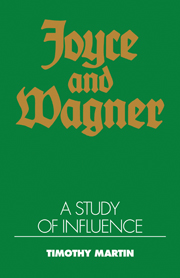7 - Joyce and Wagner
Published online by Cambridge University Press: 05 November 2011
Summary
Ah, what heights and what depths had he not touched, that formidable Master of human souls! What effort could ever equal his? What eagle could ever hope to soar higher? His gigantic work was there, finished, amidst men …
The young man saw his pathway blazed before him by victory – the long art, the short life. “Forward, still forward! Higher, ever higher!”
D'Annunzio, Il fuocoMichael Robartes remembers forgotten beauty and, when his arms wrap her round, he presses in his arms the loveliness which has long faded from the world. Not this. Not at all.
Joyce, A PortraitIn Ulysses Stephen Dedalus borrows a line from George Meredith and telegraphs Buck Mulligan a subtle accusation of ingratitude: “The sentimentalist is he who would enjoy without incurring the immense debtorship for a thing done” (U 9.550–1; 199). James Joyce, reluctant to acknowledge certain creditors of his own, may be accused of a similar offense. The Joyce of letters and conversation emerges as an artist whose imagination was conditioned by medieval churchfathers like Thomas Aquinas, classical figures like Homer and Aristotle, obscure philosophers like Vico and Bruno, and insufficiently appreciated modernists like Dujardin. An individualist and iconoclast by nature, Joyce was not inclined to recognize the distinguished artists and thinkers of his time. He would not concede “any special talent” in Proust (JJ 488), and of Lawrence he said, “That man really writes very badly … [H]is friend Aldous Huxley … at least dresses decently” (JJ 615n).
- Type
- Chapter
- Information
- Joyce and WagnerA Study of Influence, pp. 165 - 184Publisher: Cambridge University PressPrint publication year: 1991
- 1
- Cited by



